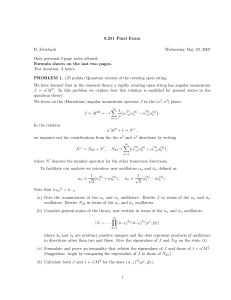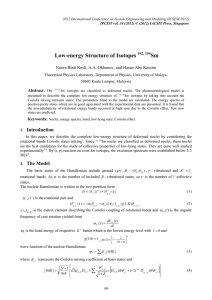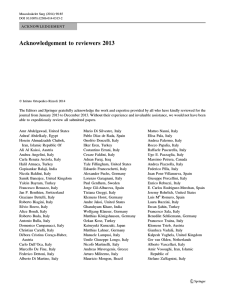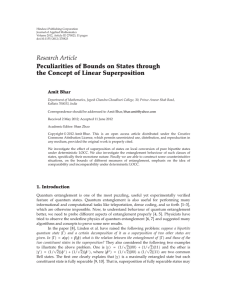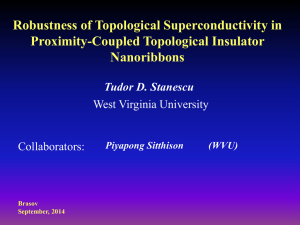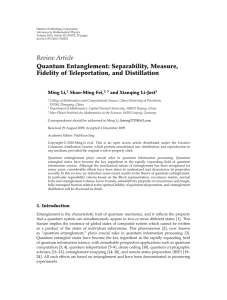Markham-Bhubaneswar
advertisement
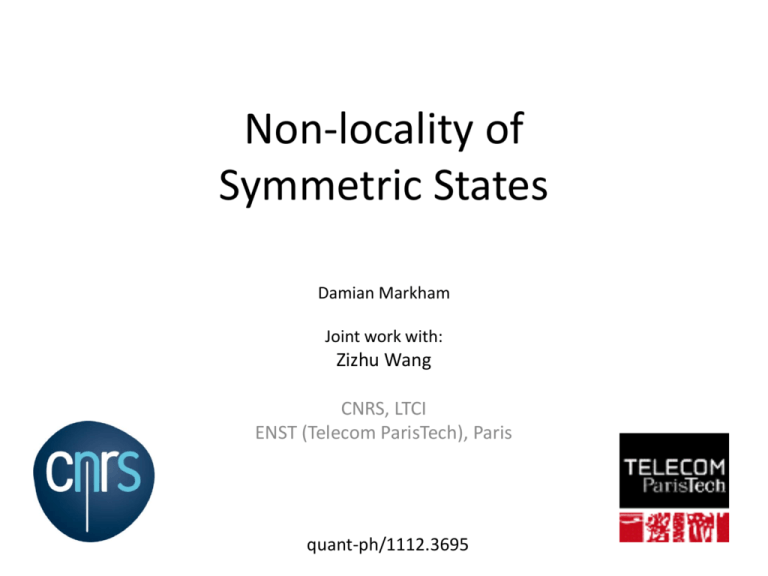
Non-locality of Symmetric States Damian Markham Joint work with: Zizhu Wang CNRS, LTCI ENST (Telecom ParisTech), Paris quant-ph/1112.3695 Motivation • Non-locality as an interpretation/witness for entanglement ‘types’? (mutlipartite entanglment is a real mess) • Different ‘types’ of non-locality? (is non-locality also such a mess?) Look at symmetric states – same tool ‘Majorana Representation’ used to study both…. Outline 1. Background (entanglement classes, non-locality, Majorana representation for symmetric states) 1. Hardy’s Paradox for symmetric states of n-qubits 2. Different Hardy tests for different entanglement classes Entanglement Definition: State is entangled iff NOT separapable rSEP = å pis i1 Ä s i2 Ä… Ä s in i entangled SEP Entanglement Types of entanglement Dur, Vidal, Cirac, PRA 62, 062314 (2000) In multipartite case, some states are incomparable, even under stochastic Local Operations and Classical Communications (SLOCC) 1 SLOCC 2 Infinitely many different classes! • Different resources for quantum information processing • Different entanglement measures may apply for different types Permutation Symmetric States Symmetric under permutation of parties H n Pij • Occur as ground states e.g. of some Bose Hubbard models • Useful in a variety of Quantum Information Processing tasks • Experimentally accessible in variety of media Permutation Symmetric States Majorana representation E. Majorana, Nuovo Cimento 9, 43 – 50 (1932) j 1,2...n = eia K åh 1 1 Perm h2 … hn 2 2 1 4 3 i cos(i / 2) 0 ei sin(i / 2) 1 i n Permutation Symmetric States Majorana representation E. Majorana, Nuovo Cimento 9, 43 – 50 (1932) j 1,2...n = eia K åh Perm 1 1 h2 … hn 2 n GHZ 2 1 000 + 111 ) ( = 2 = 2 2 å h1 h2 h3 Perm 3 1 1/ 2 0 1 2 1/ 2 0 ei 2 /3 1 2 1/ 2 0 ei 4 /3 1 Permutation Symmetric States Majorana representation E. Majorana, Nuovo Cimento 9, 43 – 50 (1932) j 1,2...n = eia K åh Perm 1 1 h2 … hn 2 n nk Dicke states S(n,k) = k 1 n å PERM 00...01..11 n-k k Permutation Symmetric States Majorana representation E. Majorana, Nuovo Cimento 9, 43 – 50 (1932) j 1,2...n = = e ia K e ia K åh h2 … h n 1 1 Perm 2 åÄh Perm i n Ädi Local unitary i U ÄU … ÄU j = 1 2 • Distribution of points alone determines entanglement features 3 2 2 4 eia K åU h 1 U h2 … U hn Perm • Orthogonality relations n 5 rotation of sphere i 0 3 Äa hi^ j =0 a ³ n - di +1 ¹0 a < n - di +1 Permutation Symmetric States GHZ4 • Different degeneracy classes* ( di ) T S (4,1) W4 Different entanglement ‘types’ (w.r.t. SLOCC) • Different symmetries^ *T. Bastin, S. Krins, P. Mathonet, M. Godefroid, L. Lamata and E. Solano , PRL 103, 070503 (2009) ^D.M. PRA (2010) Permutation Symmetric States GHZ4 • Different degeneracy classes ( di ) T Different entanglement ‘types’ (w.r.t. SLOCC) • Different symmetries • NOTE: Almost identical states can be in different classes Comparison to Spinor BEC E.g. S=2 R. Barnett, A. Turner and E. Demler, PRL 97, 180412 (2007) Phase diagram for spin 2 BEC in single optical trap (Fig taken from PRL 97, 180412) Comparison to Spinor BEC E.g. S=2 R. Barnett, A. Turner and E. Demler, PRL 97, 180412 (2007) Phase diagram for spin 2 BEC in single optical trap (Fig taken from PRL 97, 180412) Non-Locality Measurement a 0,1 basis Measurement outcome V V' a0 a 1 H A 0,1 b 0,1 H' B 0,1 Non-Locality Measurement a 0,1 basis Measurement outcome b 0,1 A 0,1 • Local Hidden Variable model B 0,1 Non-Locality Measurement basis m1 0,1 m2 0,1 M 1 0,1 mn 0,1 M 2 0,1 Measurement outcome • Local Hidden Variable model M n 0,1 n Party case (Hardy’s Paradox) • For all symmetric states of n qubits (except Dicke states) - set of probabilities which contradict LHV - set of measurement which achieve these probabilities measurement result measurement basis n Party case (Hardy’s Paradox) • For all symmetric states of n qubits (except Dicke states) - set of probabilities which contradict LHV - set of measurement which achieve these probabilities measurement result measurement basis for some , n Party case (Hardy’s Paradox) • For all symmetric states of n qubits (except Dicke states) - set of probabilities which contradict LHV - set of measurement which achieve these probabilities measurement result measurement basis for some , for same , n Party case (Hardy’s Paradox) • For all symmetric states of n qubits (except Dicke states) - set of probabilities which contradict LHV - set of measurement which achieve these probabilities measurement result measurement basis for some , for same , CONTRADICTION! n Party case (Hardy’s Paradox) • For all symmetric states of n qubits (except Dicke states) - set of probabilities which contradict LHV - set of measurement which achieve these probabilities measurement result measurement basis n Party case (Hardy’s Paradox) • Use Majorana representation Y = 1 åh 1 K Perm = a h1 G 1 2...n h 2 … hn + b h1^ 1 Än G hi^ Y = 0 2...n 0 = h1 n Party case (Hardy’s Paradox) • Use Majorana representation Y = å0 1 K Perm =a 0 G 1 2...n h2 … h n +b 1 G 1 Än 2...n hi^ Y = 0 G = 1 K ån 1 Perm 1 1 0 = h1 … n n-1 n Party case (Hardy’s Paradox) • Majorana representation always allows satisfaction of lower conditions, what about the top condition? - Must find, such that n1 ¹ hi ? 1 1 0 = h1 n Party case (Hardy’s Paradox) • Majorana representation always allows satisfaction of lower conditions, what about the top condition? - Must find, such that n1 ¹ hi - It works for all cases except product or Dicke states Dicke states too symmetric! 1 1 0 = h1 (almost) All permutation symmetric states are non-local! Testing Entanglement class Testing Entanglement class • Use the Majorana representation to add constraints implying degeneracy Y = = 1 K 1 K å h1 h2 … hn Perm åÄh Perm i i Ädi n i 0 i 0 i 0 n di 1 n di 1 Testing Entanglement class • Use the Majorana representation to add constraints implying degeneracy Y = = 1 K 1 K å h1 h2 … hn Perm åÄh Perm i i Ädi n i 0 i 0 i 0 0 = hi n di 1 n di 1 Testing Entanglement class • Use the Majorana representation to add constraints implying degeneracy Y = = 1 K 1 K å h1 h2 … hn Perm åÄh Perm i i Ädi n i 0 i 0 i 0 n di 1 n di 1 0 = hi Only satisfied by i With degeneracy di d Testing Entanglement class • Use the Majorana representation to add constraints implying degeneracy 1 K i k Perm i 1 di i i k d i 1 i n • Correlation persists to fewer sets, only for degenerate states. 0 = hi Only satisfied by i With degeneracy di d e.g. Hardy Test for W class… TW Get REAL!!! Get REAL!!! • We really need to talk about inequalities • ALL states with one MP of degeneracy or greater violate for • CanNOT be any longer true that ‘only’ states of the correct type violate - states arbitrarily close which are in different class Persistency of degenerate states S (4,1) W4 T Conclusions • Hardy tests for almost all symmetric states • Different entanglement types Different Hardy tests - Non-locality to ‘witness’ / interpret entanglement types - Different flavour of non-local arguments to Stabiliser states/ GHZ states e.t.c. • More? - ‘Types’ of non-locality? (from operational perspective) - Witness phase transitions by different locality tests? - Meaning in terms of non-local games? Thank you! http://iq.enst.fr/ COCQ FREQUENCY



